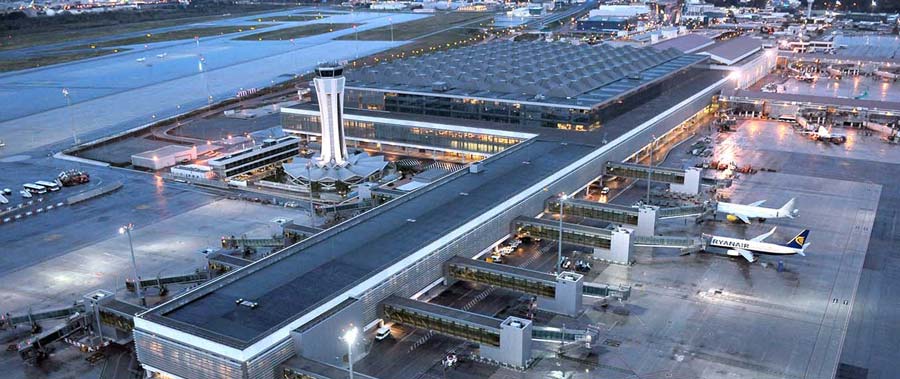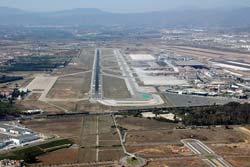Malaga Airport
In terms of passenger numbers, Malaga is number 4 with over 33% more passengers than Alicante at 5. When it comes to freight, however, Alicante handles twice as much as Malaga,
Malaga is one of the oldest airports in Spain, having opened in 1919. It also saw its first commercial flights on the 23rd of February of the same year. It acted as a stopping off point between Toulouse and Casablanca. (They also stopped off at Alicante.) The airport is situated 8km SW of Malaga and 5km north of Torremolinos. It is one of the few airports to have remained on its original site. The single runway was extended in the 1960s, and a new terminal was erected in the centre of the site. During this period of development, new navigational equipment was installed, including a radar system in early 1970. In 1965 it changed its name to become "Malaga-Costa del Sol Airport". Over the years further development has taken place, and the airport now has three terminals and a second runway. In 2002 a new 54m high control tower was opened. The airport has an integrated fuelling system at each gate removing the need for tankers to come to the aircraft.

At the height of the season, some 54 airlines use Malaga Airport, by far, the largest of these in terms of destinations served is Ryanair. The busiest routes are to Gatwick, Barcelona and Manchester. In the week before Christmas Malaga saw 872 departures to 103 destinations in 27 different countries. The busiest route with 45 flights is to Barcelona. In 2018 the airport handled 19,021,704 passengers, 2,768 tonnes of freight and saw 141,313 aircraft movements.
Alicante also opened in 1919 at Rabassa on a site now occupied by part of the University. As was mentioned earlier it was a stopping off point for the Toulouse-Casablanca flights, The Rabassa field evolved into a military airfield and during the Civil War saw a lot of action including being at the receiving end of some of it.
At the end of the 195Os, the airfield was already being used for mixed purposes: both military and civil (the passenger terminal was a small pavilion located on the site of a large modern-day shopping complex).
As a result, Alicante city council agreed to the airfield’s renovation. Nevertheless, the problems deriving from the site’s proximity to the city centre tipped the balance and a new international airport was built to the south of the city, in the area of L’Altet, part of the municipal district of Elche. After successive expansion projects, this is where the airport still stands today.
The new El Altet airport opened on 4th May 1967 and three years later passenger numbers reached one million and this prompted the building of a new terminal. The runway was extended to 3km in 1980. The airport remained the same until 1990 when a business centre was added and for the first time air bridges were installed. In 2011 the present terminal was opened and the original terminals 1 and 2 were mothballed. The plan is to build a connecting bridge and bring them back into use if numbers increase further.
The airport currently has the capacity for 20 million passengers a year but is currently running at about 12/13 million. For some time the Town Hall at Elche, within whose boundaries the airport actually sits, had been lobbying for the airport’s name to reflect its location. Their pressure paid off and since 2013 it has officially been called "Alicante - Elche Airport". If you speak Valencian (a Catalan dialect) the airport is called "Alacant - Elx".
 Iberia was the biggest user of the airport hut with the increasing dominance of low-cost carriers that position was surrendered first to EasyJet and then to Ryanair. A dispute over the use of air bridges has resulted in Ryanair cutting a number of routes since 2011. Nevertheless, they retain the top spot carrying as many passengers as the next three put together. The airport is served by 36 different airlines. The top three routes are to Gatwick, Manchester and Amsterdam. (Stansted comes in at 16.) In the week before Christmas, the airport saw 703 departures to 97 different destinations in 23 different countries. The most popular route, with 40 flights, is to Madrid.
Iberia was the biggest user of the airport hut with the increasing dominance of low-cost carriers that position was surrendered first to EasyJet and then to Ryanair. A dispute over the use of air bridges has resulted in Ryanair cutting a number of routes since 2011. Nevertheless, they retain the top spot carrying as many passengers as the next three put together. The airport is served by 36 different airlines. The top three routes are to Gatwick, Manchester and Amsterdam. (Stansted comes in at 16.) In the week before Christmas, the airport saw 703 departures to 97 different destinations in 23 different countries. The most popular route, with 40 flights, is to Madrid.
The next four places are occupied by airports on the islands with Gran Canana in sixth place and Tenerife South at number seven. Tenerife South replaced the original airport now known as Tenerife North. That airport and Gran Canaria are forever linked by the events of 27 March 1977. A bomb exploded at Gran Canaria. With the warning of another device having been made all flights were diverted to Tenerife, an airport not used to handling large numbers of aircraft and certainly not Jumbo Jets. The result was that it became the site of the world’s worst-ever aviation disaster.

